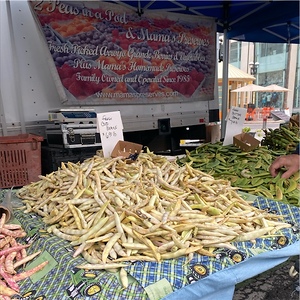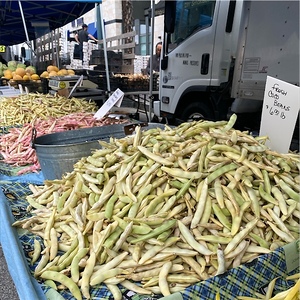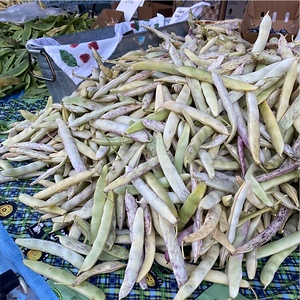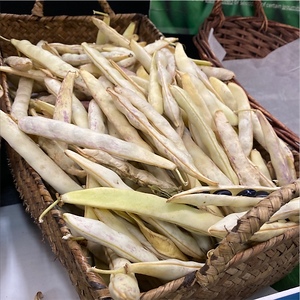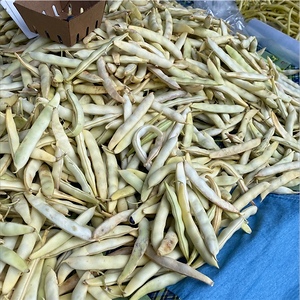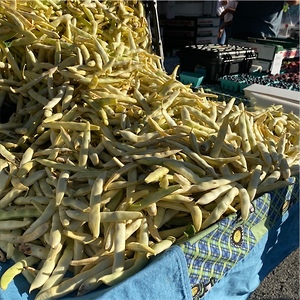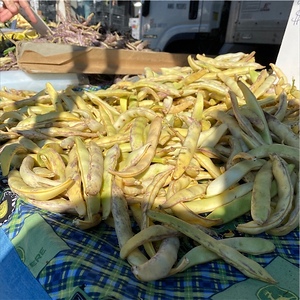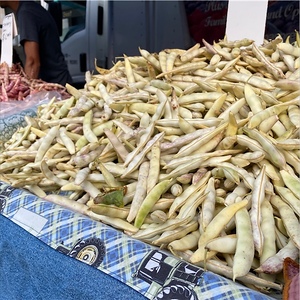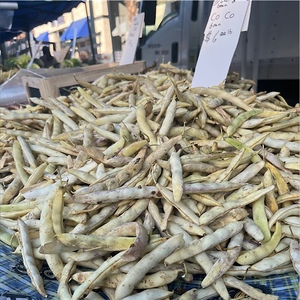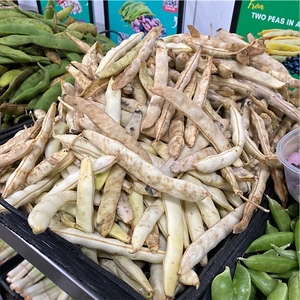


Black Coco Shelling Beans
Estimated Inventory, lb : 0
This item was last sold on : 08/15/24
Description/Taste
Black Coco shelling beans are encased in long, slender pods that average about 13 centimeters in length. These pods start off with a bright, grassy green hue and mature to a banana yellow tone. There may be brown spots speckled across the pods once they turn yellow. Black Coco shelling bean pods are smooth and soft with bumpy indentations where the beans reside. They usually contain 5 to 6 medium-sized beans with an ovate to round shape that can be slightly curved. These black beans are connected to the pod by a tiny fragment of flesh that creates an eye in each bean once removed. The beans have a glossy and smooth texture. When cooked, they take on a swollen, dense, and meaty consistency with a nutty flavor.
Seasons/Availability
Black Coco shelling beans are available from mid-summer to early fall.
Current Facts
Black Coco shelling beans, botanically classified as Phaseolus vulgaris, belong to the Fabaceae family. Like other beans in this family, they can be harvested when immature for fresh eating or left to fully mature and used as shelling beans. This variety is a bush bean, characterized by a compact, self-supporting growth pattern that reaches up to 60 centimeters in height and does not require trellises or stakes. As the beans ripen, the cottony flesh of the pod loses moisture, allowing them to loosen easily. Once dried, Black Coco shelling beans continue to shrink and harden as they age.
Nutritional Value
Like most varieties of black beans, Black Coco shelling beans are nutrient-dense legumes that provide the body with vitamins A and B. These vitamins play a role in immune, nerve, and brain function, vision and skin health, infection defense, energy production, cell metabolism, and mood regulation. They contain calcium, which is important for maintaining strong bones and teeth. The folate and magnesium content in Black Coco shelling beans are important for reproductive and emotional health, calcium absorption, muscle contraction, and reducing stress. The iron in these beans helps with oxygen transport and supports overall vitality. They are also rich in potassium, aiding in heart health and maintaining proper fluid balance, while their high protein and fiber content encourages muscle repair, digestive health, and satiety.
Applications
Black Coco shelling beans can be simmered, sautéed, fried, or braised. They are often used in soup recipes with vegetables, lentils, and meats. When simmered in a clay or iron pot, they require only water and mirepoix to enhance their natural flavors. Black Coco shelling beans can mixed into pasta, incorporated in salads, added to casseroles, or paired with Mexican dishes like tacos and burritos. When immature, they can be used as a snap bean and prepared similarly to romano beans. Complimentary pairings include tomatoes, corn, chiles, garlic, oregano, parsley, cilantro, leeks, pork, roasted fish, curry, vinegar, and olive oil. Mature beans should always be cooked prior to eating. To store, keep fresh Black Coco shelling beans refrigerated and use within four to five days.
Ethnic/Cultural Info
Black Coco shelling beans may be a relative of the renowned White Coco bean, or le Coco de Paimpol, the first fresh vegetable to obtain a protected appellation d'origine contrôlée status in France. This status is only awarded to products cultivated within specific regions, guaranteeing the quality and authenticity of the production methods used. Initially, France favored white beans and resisted darker varieties, such as Black Coco shelling beans, due to their tendency to bleed color onto other ingredients during cooking. Coco de Paimpol beans became a popular export from Brittany, France, and are now cultivated in the district of Côtes-d´Armor. These beans are still harvested by hand by thousands of pickers who manually separate each pod from their stems.
Geography/History
The exact origins of Black Coco shelling beans is not known, but they likely came from the Rio Coco region of Nicaragua and Honduras and were brought to France through trade routes between the Americas and Europe. It wasn’t until the mid-1900s when recipes for black bean soup began appearing in notable cookbooks that they gained popularity. Eventually, this variety was established as a valued crop in French cuisine. Black Coco shelling beans thrive in warm, sunny climates with no risk of frost. As a cultivated variety, they are not found in the wild. Outside of France, Black Coco shelling beans are relatively rare and primarily sown as home garden beans or grown for farmers' markets.
Recipe Ideas
Recipes that include Black Coco Shelling Beans. One
| San Diego Foodstuff |
|
Three-Bean Summer Salad with Warm Beef Bacon Vinaigrette |



